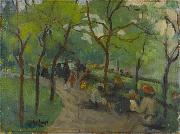Wholesale Oil Painting No Minimum |
|||||||||||
|
|
|||||||||||

|
|||||||||||
|
|
|
||||||||
George Benjamin Luks(August 13, 1867-October 29, 1933) was an American realist artist and illustrator. His vigorously painted genre paintings of urban subjects are examples of the Ashcan school in American art. Luks was born in Williamsport, Pennsylvania, to Central European immigrants. His father was a physician and his mother was an amateur painter and musician.The Luks family (George, his parents and five siblings) eventually moved to Pottsville, in Southern Pennsylvania near the coal fields. In this setting, he learned at a young age the importance of compassion by watching how his parents helped the coal miners' families, and many believe that this is the reason why lower class New Yorkers were often Luks's subject matter. Luks studied at the Pennsylvania Academy of Fine Arts before he traveled though Europe where he attended several art schools. Later he went to Desseldorf where he lived with a distant relative, a retired lion-tamer. He abandoned Desseldorf for the more stimulating spheres of London and Paris. He then returned to Philadelphia in 1893 where he was an illustrator for the Philadelphia Press where he met John Sloan, William Glackens, and Everett Shinn. They would meet at the studio of Robert Henri, an artist who emphasized the depiction of ordinary life, shunning genteel subjects and painting quickly. The group became known as the "Philadelphia Five". In 1896, Luks moved to New York and began his art career there as the premier humorist artist for the New York World. During his time as an illustrator there, he lived with William Glackens. |
||||||||
|
|
||||||||
Prospect Park
Prospect Park Painting ID:: 71630 |
between 1902(1902) and 1910(1910)
Oil on panel
21.5 x 28.5 cm (8.46 x 11.22 in)
between 1902(1902) and 1910(1910) Oil on panel 21.5 x 28.5 cm (8.46 x 11.22 in) |
|||||||
|
|
||||||||
|
WEST, Benjamin American Neoclassical Painter, 1738-1820 American historical painter who worked in England. He was born in Springfield, Pa., in a house that is now a memorial museum at Swarthmore College. After some instruction from a local artist named William Williams, he set up as a portrait painter in Philadelphia at 18, subsequently moving to New York City. In 1760 he went to Europe, where he remained for the rest of his life. For three years he studied in Italy. Working under the tutelage of Anton Mengs, he was also inspired by the classical research of Johann Winckelmann. He then settled in London, becoming a leader of the neoclassical movement. Under the patronage of George III, commissions came to him in great numbers, and in 1772 he was appointed historical painter to the king. A founder of the Royal Academy, he succeeded Sir Joshua Reynolds as its president in 1792. West executed more than 400 canvases, chiefly historical, mythological, and religious subjects painted on a heroic scale. He had many pupils and was a generous friend and adviser to younger artists, particularly American painters studying in England, among whom were Washington Allston, Samuel Morse, Charles Willson Peale, Gilbert Stuart, and John Singleton Copley. His influence on American painting of the period was predominant. Among West's best-known works are Death of General Wolfe (Grosvenor Gall., London) and Penn's Treaty with the Indians (Pa. Acad. of the Fine Arts). In these paintings he created a new departure in historical painting by clothing his figures in the costume of their period instead of the traditional classical garb. Prospect Park Date between 1902(1902) and 1910(1910) Medium Oil on panel Dimensions 21.5 X 28.5 cm (8.46 X 11.22 in) cyf |
||||||||
|
|
||||||||
|
Prev Next
|
||||||||
|
|
||||||||
|
Related Paintings to WEST, Benjamin :. |
||||||||
|
|
||||||||
|
CONTACT US |

